■Basic life support procedure
Learn basic life support procedure
Use AED if any people don't have "breathing." |
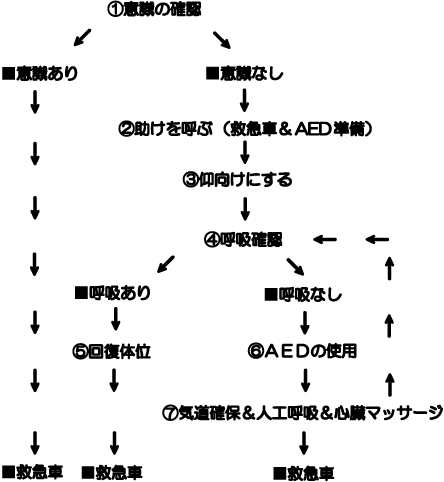
|
①Confirmation of consciousness
At ears, yell "Do you understand?"
If conscious, you will listen to his request and provide first aid.
Even if he is conscious, call ambulance if necessary.
|
②Call for help (ambulance & AED preparation)If he is unconscious, call out for help.
Request ambulance call and AED preparations to the people around you.
If there are no people around you, call ambulance yourself, and if there is an AED around you, go to get AED.
|
③Lay on back
Place one hand on the back of his head to prevent to injury his neck, and place your other hand on his shoulder and lay him on his back.
If his wetsuit Interfere basic life support, remove it or cut it with scissors.
|
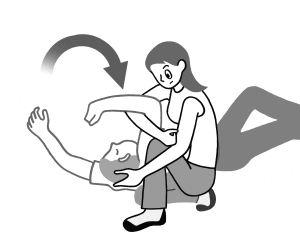
|
④Confirmation of breathing
See patient's chest and upper abdominal movements and if patient dosen't have breathing, use AED.
|
⑤Recovery position
If he is "breathing" even if he is unconscious, wait for the paramedics in a recovery position so that his breathing is not blocked.
Turn his body sideways to either the left or right, bend his head to secure the airway, bend his elbows of both hands, and place the back of his upper hand under his head.
Bend his upper knee about 90 degrees so that his body doesn't fall over later.
Turn his mouth toward the floor so that the vomit naturally flows out.
The body temperature of the diver pulled up from the water may have dropped, so keep his body warm with a blanket or rescue sheet.
|

|
⑥Use of AED
If you decide that he is not "breathing", use the AED "immediately" and follow the AED voice message.
If you cannot use the AED "immediately", follow the procedure
⑦ " Airway Open & Breathing & Circulation".
|
|
1 Turn on the AED.
(There is also a type that powers on automatically when the cover is opened.)
2 Take out the electrode pad.
|
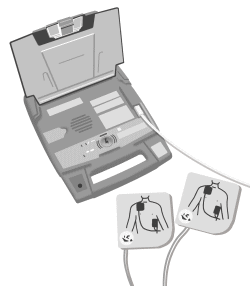
|
|
3 Take off his clothes and attach the electrode pad to his chest.
After applying the electrode pad, do not touch him.
Please be careful not to let other people near him.
If he is wet, such as immediately after removing his wetsuit, be sure to wipe off water.
Remove anything that touches his body, such as accessories.
|
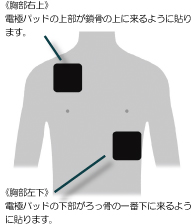
|
| 4 AED begins to analyze the electrocardiogram.
5 If defibrillation (removing the heart's cramps) is required, a voice
message will be played and charging will start automatically.
The button flashes when charging is complete.
6 Make sure that the people around you are well separated from the patient,
then press the flashing button.
Be careful not to touch the patient until defibrillation (removing the
heart' sconvulsions) is complete.
|

|
| 7 AED analyzes electrocardiogram after defibrillation (removal of heart spasm).
8 Repeat steps 5-7 according to the AED voice message.
9 When defibrillation (removing the heart's cramps) is no longer needed, the AED will tell you to give artificial respiration and heart massage.
Perform artificial respiration and heart massage with the electrode pad
attached.
10 Even if patient's pulse, breathing, and consciousness return to normal, leave the electrode pads on the patient and the power on until the ambulance arrives.
|
⑦Airway open & Breathing & Circulation
* If you are waiting for the AED to arrive, stop the below procedure and use the AED when it is ready.
Opening the airway so that it does not close is called "A"irway
open.
"B"reathing is a method of blowing exhalation into the lungs and sending oxygen to the blood.
Exhalation is the air after taking oxygen in the lungs and expelling carbon dioxide, but 16-18% oxygen remains.
This 16-18% oxygen is at a concentration sufficient to sustain life, so it is okay to use this for the patient by "B"reathing.
"C"irculation is a method of compressing a stopped heart and sending blood throughout the body.
Don't do a normal person "C"irculation and "B"reathing for this practice.
A special doll is used for this practice.
In the lifesaving of drowning people, "A"irway open and "Breathing" is the first priority.
Let's remember "ABC".
Unlike the lifesaving procedure for a drowning person, the lifesaving procedure for respiratory stop due to a heart disease is "CAB" because "C"irculation is the first priority.
|

|
|
1 Place the patient on his back on a firm surface or a plate larger than
the chest.
2 Knee on one side of the patient's chest.
3 Remove dentures that can block the airways and thus breath.
It is not necessary to remove the total denture if it is convenient to
maintain the shape of the mouth during "B"reathing.
4 With the thumbs of both hands, hold the pocket mask close to the patient's face and cover the nose and mouth.
The pocket mask is a compact mask that can be folded and placed in a pocket.
|
|

|
|
5 To secure the airway, Place both hands on the bent parts of the left and right lower jaw and pull the lower jaw forward until the teeth of the lower jaw come forward and protrude.
|
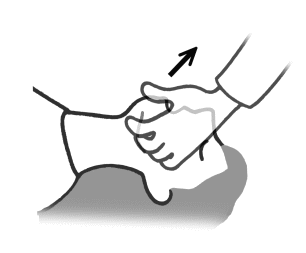
Pull the lower jaw forward
|
|
6 After opening the airway, do "B"reathing.
After the rescuer breathe in himself, blow into the patien for 1 second
until
patient's chest slowly and lightly swells.
At this time, if you can't confirm the swells of patient's chest, check
air leak
between the pocket mask and patient's face.
If you blow in too fast, or if you blow in too much, air will enter patient's
stomach.
The amount of air blown into an adult should be around 500 to 800 ml.
Stop blowing into and watch patient's chest shrink.
Repeat this blowing into 5 times continuously.
|
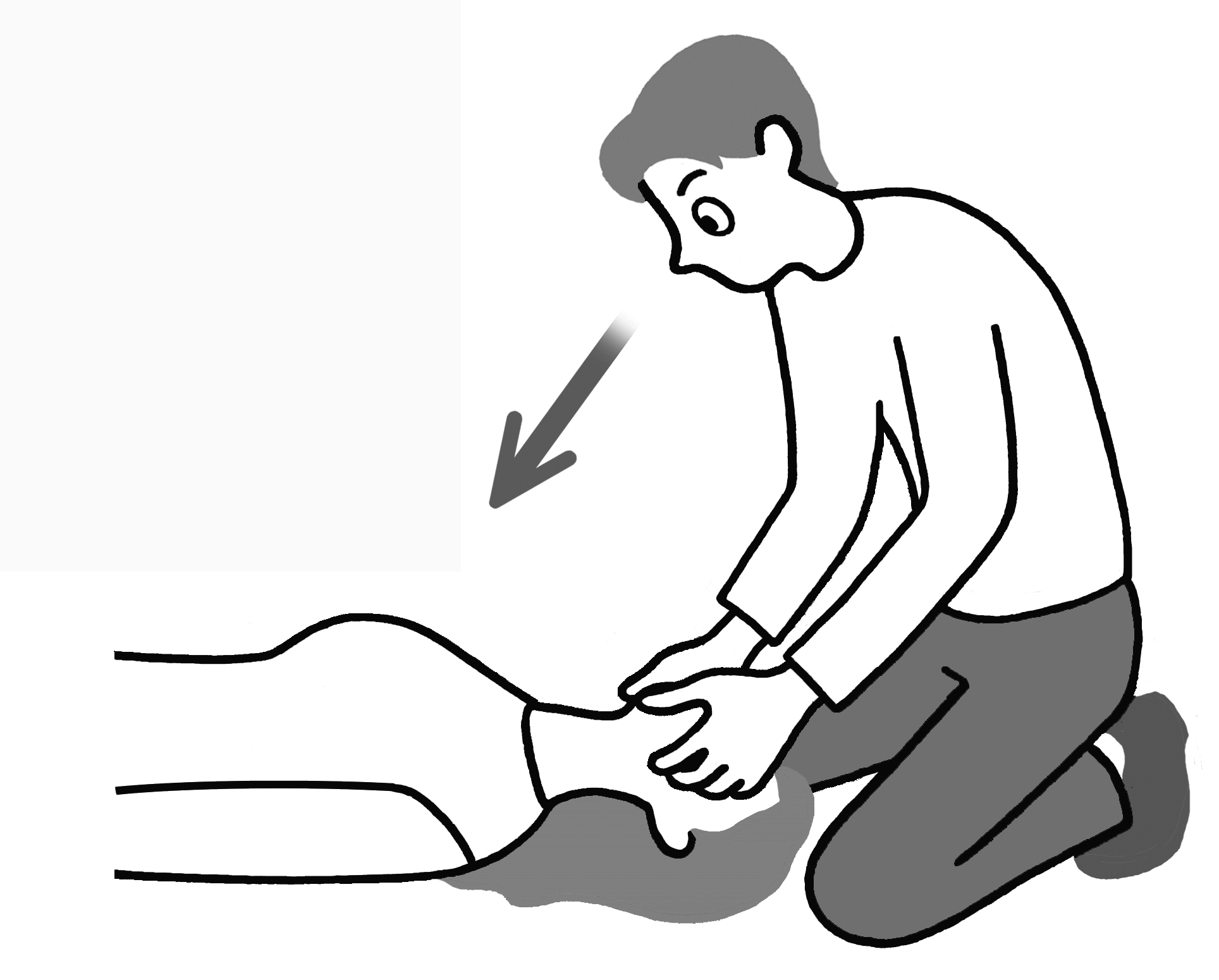
Make sure patient's chest is shrinking
|
|
7 After "breathing", chek patient's chest and upper abdominal movements and chek if patient breath or not.
If the patient start to breath, put the patient in recovery position and
wait for
an ambulance.
8 If the patient dosen't start to breath, do "C"irculation.
The place where should be pressed is the "middle of the chest."
A guideline is on the line connecting the nipples.
|
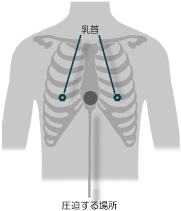
|
|
9 Place the part near the wrist of one hand palm on a place to be compressed,
and place the palm of another hand on the back of one hand.
At this time, both hands should be overlapped and that the fingers of both
hands should be crossed together and be away from the chest so that they
do not touch the chest.
|
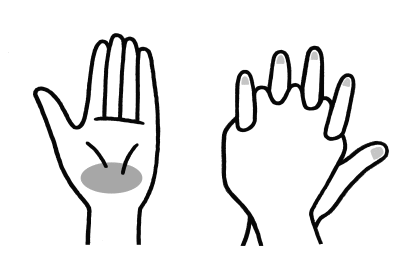
|
|
10 Straight both elbows, press vertically with your upper body weight resting on your palm.
|
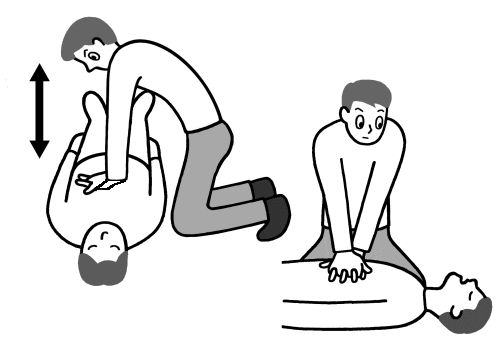
|
|
11 Press speed is at least 100 times per minute and press down on the
sternum by at least 5 cm.
|
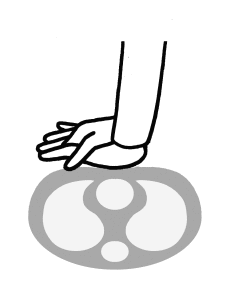
|
|
12 Press 30 times continuously.
Between compression and next compression, keep your hands on patient's
chest and stop compression completely.
Compression time should be the almost same as non-compression time.
|
|
13 If the patient start to breath, put the patient in recovery position
and wait for an ambulance.
14 If the patient dosen't start to breath, blow into 2 times continuously and then give "B"reathing and "C"irculation by following the above procedure from "7" to "14".
After the first 5 blows(the blows number of the above "6" procedure),
the
number of "B"reathing and "C"irculation should be 30
("C"irculation): 2
("B"reathing). Do not give up and continue until the ambulance
arrives.
|
|
The number of "B"reathing and "C"irculation may be more or less than 30: 2 , but continue "B"reathing and "C"irculation with confidence and don't stop them.
If you are waiting for the AED to arrive, stop "B"reathing and "C"irculation
and use the AED when it is ready.
|

When there is only one rescuer
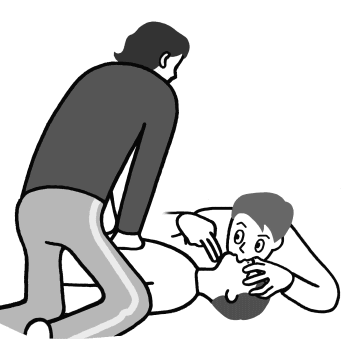
When there is tow rescuers
|
|
To prevent lung rupture, do not do "B"reathing and "C"irculation at the same time.
Be sure to do them alternately.
|
|
|

